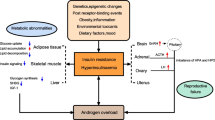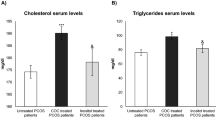Abstract
Polycystic ovary syndrome (PCOS) is the most common disorder of ovarian function in premenopausal women. PCOS is characterised by chronic anovulation and androgen excess with clinical manifestation of irregular menstrual cycles, hirsutism and/or acne. Insulin resistance with resultant hyperinsulinaemia, irrespective of excess weight or frank obesity, has been reported in patients with PCOS, and, as insulin has a direct effect on ovarian androgen production in vitro, insulin resistance may play a crucial role in the physiopathology of PCOS. Although the molecular mechanism(s) of insulin resistance in PCOS is unclear, excessive insulin-independent serine phosphorylation of the β subunit of the insulin receptor, as reported in some patients with PCOS, has been put forward as a new mechanism for insulin resistance.
Insulin-sensitising agents have recently been investigated for their role in the short term treatment of insulin resistance in PCOS. Controlled studies have shown that metformin administration, by promoting bodyweight loss, can decrease fasting and stimulated plasma insulin levels. However, other studies have shown metformin 500mg 3 times daily to decrease insulin secretion and to reduce ovarian production of 17α-hydroxyprogesterone with recovery of spontaneous or clomifene-induced ovulation, independently of weight loss. These findings suggest a new indication for metformin and present insulin-sensitising agents as a novel approach in the treatment of ovarian hyperandrogenism and abnormal ovulation in PCOS. They also suggest that long term administration of metformin might be helpful in treating insulin resistance, thus reducing risks of type 2 (non-insulin-dependent) diabetes and cardiovascular disease in these patients.
Similar content being viewed by others
References
Franks S. Polycystic ovary syndrome. N Engl J Med 1995; 333: 853–61
Poison DW, Wadsworth J, Adams J, et al. Polycystic ovaries — a common finding in normal women. Lancet 1988; 1: 870–2
Dahlgren E, Johansson S, Lindstedt G, et al. Women with polycystic ovary syndrome wedge resected in 1956 to 1965: a long-term follow-up focusing on natural history and circulating hormones. Fertil Steril 1992; 57: 505–13
Dahlgren E, Janson PO, Johansson S, et al. Polycystic ovary syndrome and risk for myocardial infarction — evaluated from a risk factor model based on a prospective study of women. Acta Obstet Gynecol Scand 1992; 71: 599–604
Conway GS, Agrawal R, Betteridge DJ, et al. Risk factors for coronary artery disease in lean and obese women with the polycystic ovary syndrome. Clin Endocrinol 1992; 37: 119–25
Robinson S, Henderson AD, Gelding SV, et al. Dyslipidemia is associated with insulin resistance in women with polycystic ovaries. Clin Endocrinol 1996; 44: 277–84
Franks S. Polycystic ovary syndrome: approaching the millennium. Hum Reprod 1997; 12 Natl. Suppl.: 43–5
Dunaif A. Insulin resistance and the polycystic ovary syndrome: mechanism and implications for pathogenesis. Endocrine Rev 1997; 6: 774–800
Dunaif A, Xia J, Book C, et al. Excessive insulin receptor serine phosphorylation in cultured fibroblasts and in skeletal muscle: a potential mechanism for insulin resistance in the polycystic ovary syndrome. J Clin Invest 1995; 96: 801–10
Legro RS. The genetics of polycystic ovary syndrome. Am J Med 1995; 98: 9S–16S
Carey AH, Chan KL, Short F, et al. Evidence for a single gene effect causing polycystic ovaries and male pattern baldness. Clin Endocrinol 1993; 38(6): 653–8
Bates G, Whitworth MS. Effect of body weight reduction on plasma androgens in obese, infertile women. Fertil Steril 1982; 38: 409
Pasquali R, Antenucci D, Casimirri F, et al. Clinical and hormonal characteristics of obese amenorrheic hyperandrogenic women before and after weight loss. J Clin Endocrinol Metab 1989; 68: 173–9
Kiddy DS, Hamilton-Fairley D, Seppälä M, et al. Diet-induced changes in sex hormone binding globulin and free testosterone in women with normal or polycystic ovaries; correlation with insulin and insulin-like growth factor-I. Clin Endocrinol 1989; 31: 757–63
Kiddy DS, Hamilton-Fairley D, Bush A, et al. Improvement in endocrine and ovarian function during dietary treatment of obese women with polycystic ovary syndrome. Clin Endocrinol 1992; 36: 105–11
Nicolas MH, Crave JC, Fimbel S, et al. Hyperandrogénie de la femme hirsute et obése, effets d’un régime hypocalorique. Presse Méd 1993; 22: 19–22
Guzick DS, Wing R, Smith D, et al. Endocrine consequences of weight loss in obese, hyperandrogenic, anovulatory women. Fertil Steril 1994; 61: 598–604
Clark AM, Ledger W, Gallety C, et al. Weight loss results in significant improvement in pregnancy and ovulation rates in anovulatory obese women. Hum Reprod 1995; 10: 2705–12
Hollman M, Runnebaum B, Gerhard I. Effects of weight loss on the hormonal profile in obese, infertile women. Hum Reprod 1996; 11: 1884–91
Jakubowicz DJ, Nestler JE. 17α-hydroxyprogesterone responses to leuprolide and serum androgens in obese women with and without polycystic ovary syndrome after dietary weight loss. J Clin Endocrinol Metab 1997; 82: 556–60
Ehrmann DA, Barnes RB, Rosenfield RL. Polycystic ovary syndrome as a form of functional ovarian hyperandrogenism due to dysregulation of androgen secretion. Endocrine Rev 1995; 13: 322–53
Hopkinson ZEC, Sattar N, Fleming R, et al. Polycystic ovarian syndrome: the metabolic syndrome comes to gynaecology. BMJ 1998; 317: 329–32
Bailey CJ, Turner RC. Metformin. N Engl J Med 1996; 334: 574–9
DeFronzo RA, Barzilai N, Simonson DC. Mechanism of metformin action in obese and lean noninsulin-dependent diabetic subjects. The Multicenter Metformin Study group. J Clin Endocrinol Metab 1991; 73: 1294–1301
Sattar N, Hopkinson ZEC, Greer IA. Insulin-sensitising agents in polycystic ovary syndrome. Lancet 1998; 351: 305–6
Velazquez EM, Mendoza S, Hamer T, et al. Metformin therapy in polycystic ovary syndrome reduces hyperinsulinemia, insulin resistance, hyperandrogenemia, and systolic blood pressure, while facilitating normal menses and pregnancy. Metabolism 1994; 43: 647–54
Velazquez EM, Acosta A, Mendoza SG. Menstrual cyclicity after metformin therapy in polycystic ovary syndrome. Obstet Gynecol 1997; 90: 392–5
Velazquez EM, Mendoza SG, Wang P, et al. Metformin therapy is associated with decreased plasma plasminogen activator inhibitor-1, lipoprotein(a), and immunoreactive insulin levels in patients with polycystic ovary syndrome. Metabolism 1997; 46: 454–7
Acbay O, Gündogdu S. Can metformin reduce insulin resistance in polycystic ovary syndrome? Fertil Steril 1996; 65: 946–9
Ehrmann DA, Cavaghan MK, Imperial J, et al. Effect of metformin on insulin secretion, insulin action, and ovarian steroidogenesis in women with polycystic ovary syndrome. J Clin Endocrinol Metab 1997; 82: 524–30
Nestler JE, Jakubowicz D. Decrease in ovarian cytochrome P450c17α activity and serum free testosterone after reduction of insulin secretion in polycystic ovary syndrome. N Engl J Med 1996; 335: 617–23
Nestler JE, Jakubowicz D. Lean women with polycystic ovary syndrome respond to insulin reduction with decreases in ovarian P450cl7α activity and serum androgens. J Clin Endocrinol Metab 1997; 82: 4075–9
Diamantis-Kandarakis E, Kouli C, Tsianatelli T, et al. Therapeutic effects of metformin on insulin resistance and hyper-androgenism in polycystic ovary syndrome. Eur J Endocrinol 1998; 138: 269–74
Morin-Papunen LC, Koivunen RM, Ruokonen A, et al. Metformin therapy improves the menstrual pattern with minimal endocrine and metabolic effects in women with polycystic ovary syndrome. Fertil Steril 1998; 69: 691–6
Morin-Papunen LC, Koivunen RM, Tomas C, et al. Decreased serum leptin concentrations during metformin therapy in obese women with polycystic ovary syndrome. J Clin Endocrinol Metab 1998; 83: 2566–8
Nestler JE, Jakubowicz DJ, Evans WS, et al. Effects of metformin on spontaneous and clomiphene-induced ovulation in the polycystic ovary syndrome. N Engl J Med 1998; 338: 1876–80
Crave J, Fimbel S, Lejeune H, et al. Effects of diet and metformin administration on sex hormone-binding globulin, androgens, and insulin in hirsute and obese women. J Clin Endocrinol Metab 1995; 80: 2057–62
Coetzee EJ, Jackson WPU. Metformin in the management of pregnant insulin-dependent diabetics. Diabetologia 1979; 16: 241–5
Author information
Authors and Affiliations
Corresponding author
Rights and permissions
About this article
Cite this article
Pugeat, M., Ducluzeau, P.H. Insulin Resistance, Polycystic Ovary Syndrome and Metformin. Drugs 58 (Suppl 1), 41–46 (1999). https://doi.org/10.2165/00003495-199958001-00010
Published:
Issue Date:
DOI: https://doi.org/10.2165/00003495-199958001-00010




